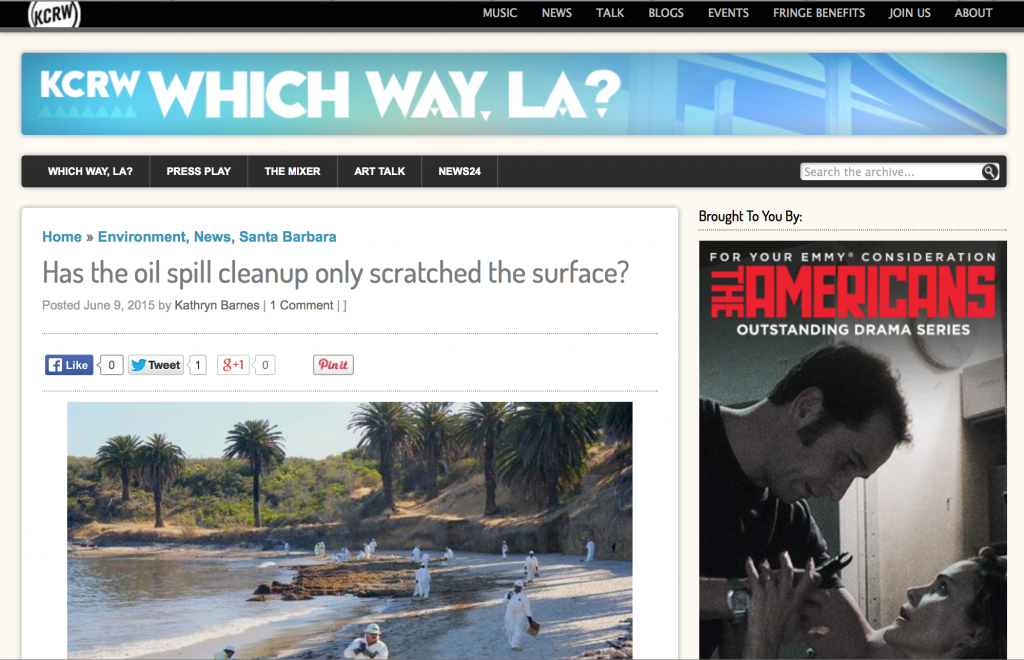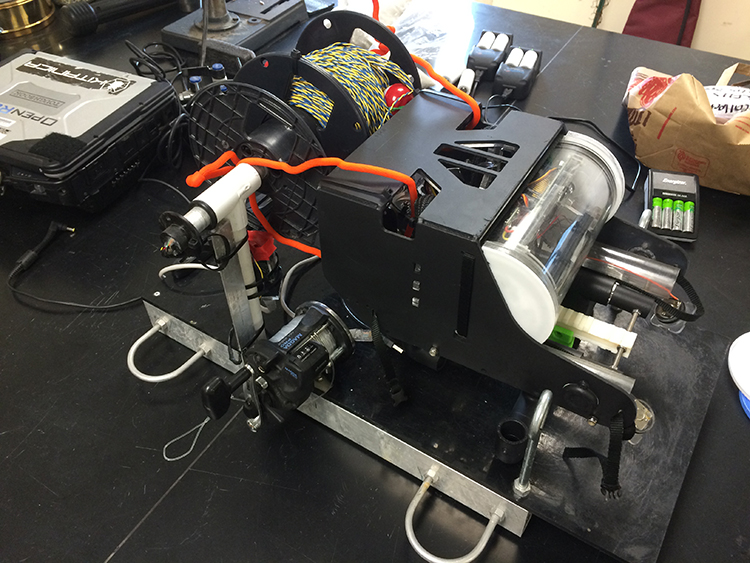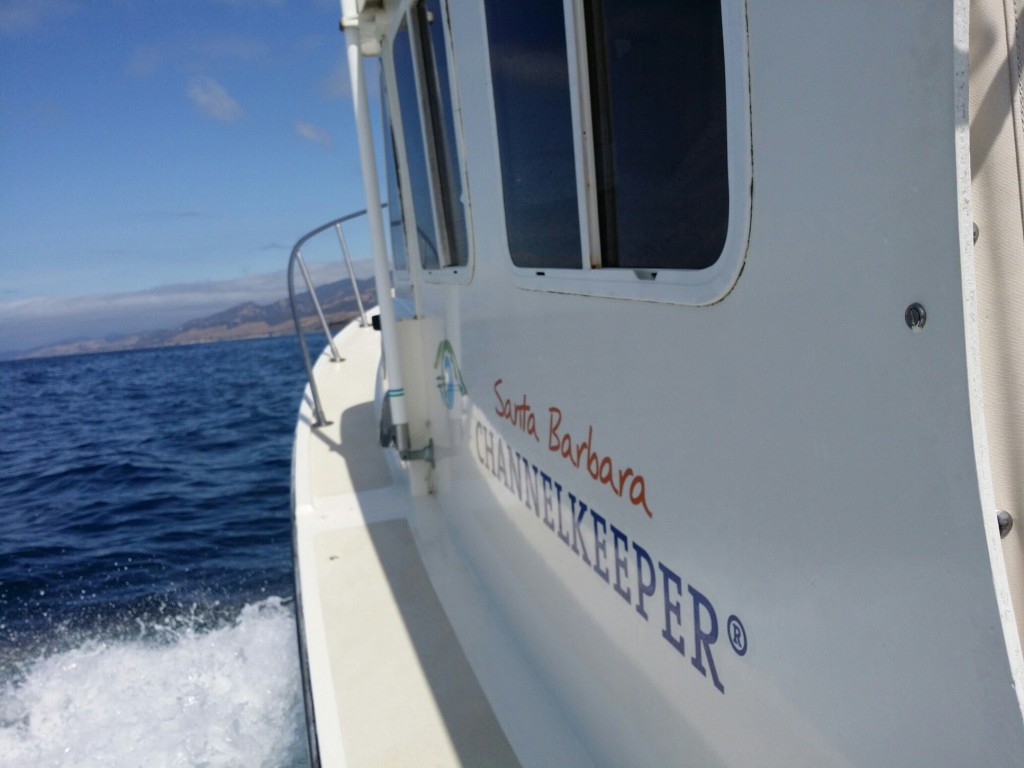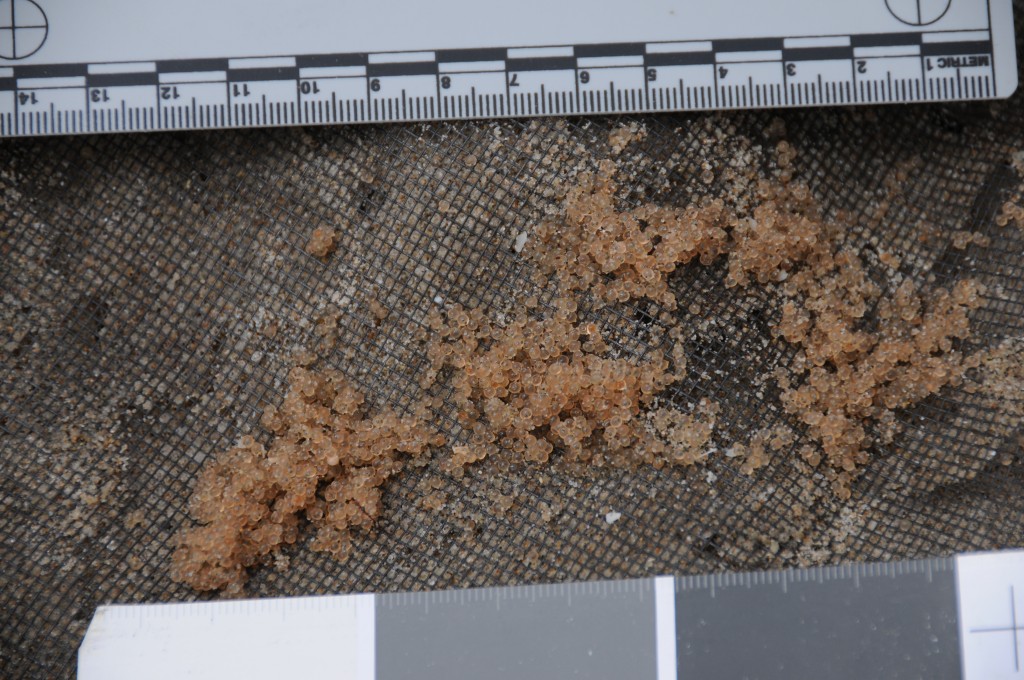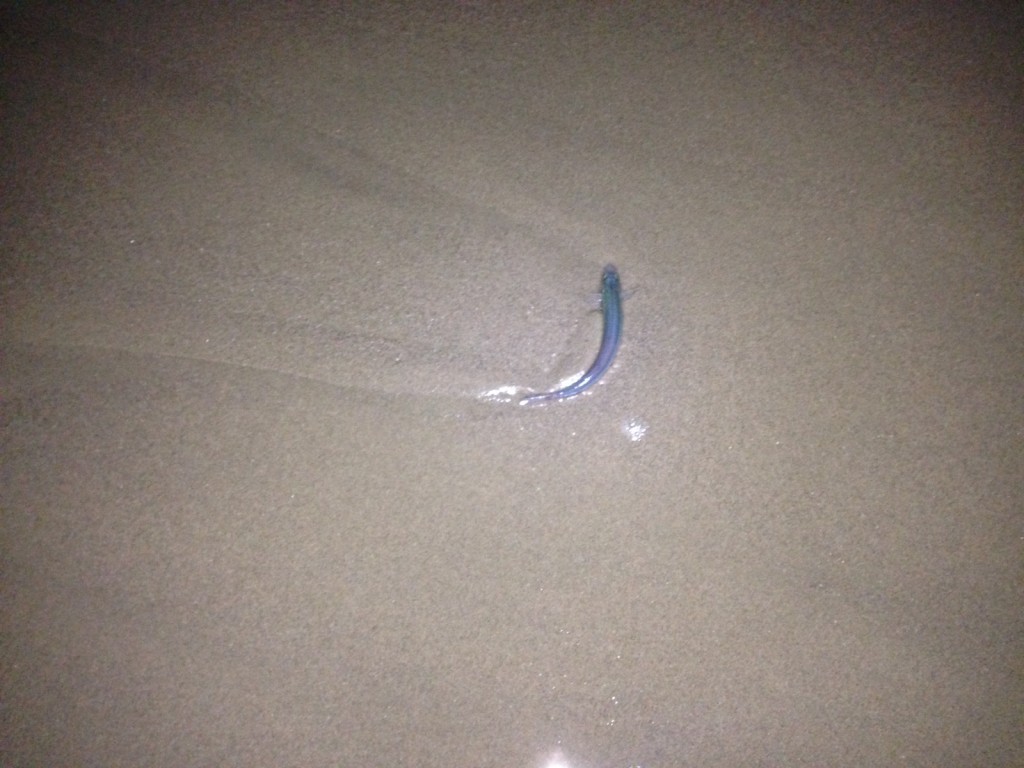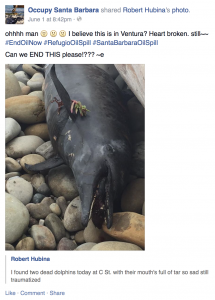Posts
LA Beaches pretty clean
/in Field Work /by Sean AndersonNote: this is a field posting from a Mobil device, please excuse errors. This post will be cleaned up this evening.
We have been getting to our more routine survey sites in Los Angeles County over the past few days. We have seen no evidence of more recent tarring. Generally the beaches in LA look good, although there has been a moderate amount of tR incorporated into the subsurface sand matrix due to mechanical grooming/raking of the sand, wave action, and our recent strong winds.
Malibu is quite clean with respect to tar, although there is a swimming advisory due to FIB in the lagoon (as often happens in summer).

Santa Monica is superficially clean, but there appears to be a good amount of larger (quarter to fist-sized) tR balls just subsurface on the upper reaches of the primary beach face. I do not think this is a human or ecological threat per se, but the tar is certainly not “gone” as you might think after a cursory inspection.
This is the amount of tar from two 0.5 x 0.5 m quadrat near the wrack line at Santa Monica Beach. A third quadrat had no tar:
Our ROVs: Prowling for Oil
/in benthos, field surveys, oiling, PIRatE Lab, Remotely Piloted Systems, robots, ROV, RPS, tar balls, tarring /by Sean AndersonNote: This is a partial re-post with some modifications from my students’ Aerial and Aquatic Robotic Research Blog.
Check out what my students are doing now and have been doing in recent months with these killer new tools here: The AARR PIRatE Lab Blog. Several of them are exhibiting some of our flying and swimming units at the national DARPA Challenge finals all weekend in Pomona. We were invited to participate in this event by the DoD both due to our excellent outreach and educational efforts across all education levels (middle school, high school, and university) and for our pioneering efforts to use cheap, open source robotics to monitor the coastal zone. Combing the seafloor for oil is but our latest adventure and application for these powerful new tools for environmental assessment. See my students’ blog for what we have been doing and consider swinging by the event at the Pomona Fairplex in Pomona, CA today for the free-to-the-public demos and competition.
What are we doing with robots?
We are using our cheap, small, open source robots to hunt for any evidence of deposited oil on the seafloor near the spill epicenter at Refugio State Beach on May 19. We are interested in assessing the ocean floor near the oil spill site for the presence and density of any subsurface mats, tarballs, oiled algal stands/seagrass meadows, or signs of potentially affected wildlife.
Getting there has been half most of the challenge
We have been pursuing access to the seafloor in the restricted access zone (the area upcoast and downcast from the Refugio pipeline break) for the past two weeks (see Pacific Standard’s piece on this very issue here) through all the formal and informal channels we know of. Daily calls and frequent electronic requests to the JIC and to incident command member agencies have gone nowhere and we still have not been granted access/permission to deploy our tools inside the immediate spill zone. This has been frustrating as we believe we have unique tools that can document deposited oil on the benthos and create a visual record of the amount for the permanent/legal record. Everyone we talk to seems to think our ROV (Remotely Operated Vehicle) survey is a great idea, but no one would pull the trigger to allow us or any of our partners access to the site.
As we have yet to secure legal permission to enter the area where oil was most likely deposited, we opted for the next best thing. This past Thursday we did a quick inspection of Naples Reef, a Marine Protected Area about 14 km (8.5 mi) from the Refugio spill and an area outside the restricted zone. Our Santa Barbara Channelkeeper colleagues have a keen and long-running interest in the goings on a Naples and have been anxious to confirm any (hopefully minor or non-existent) impacts to the reef.
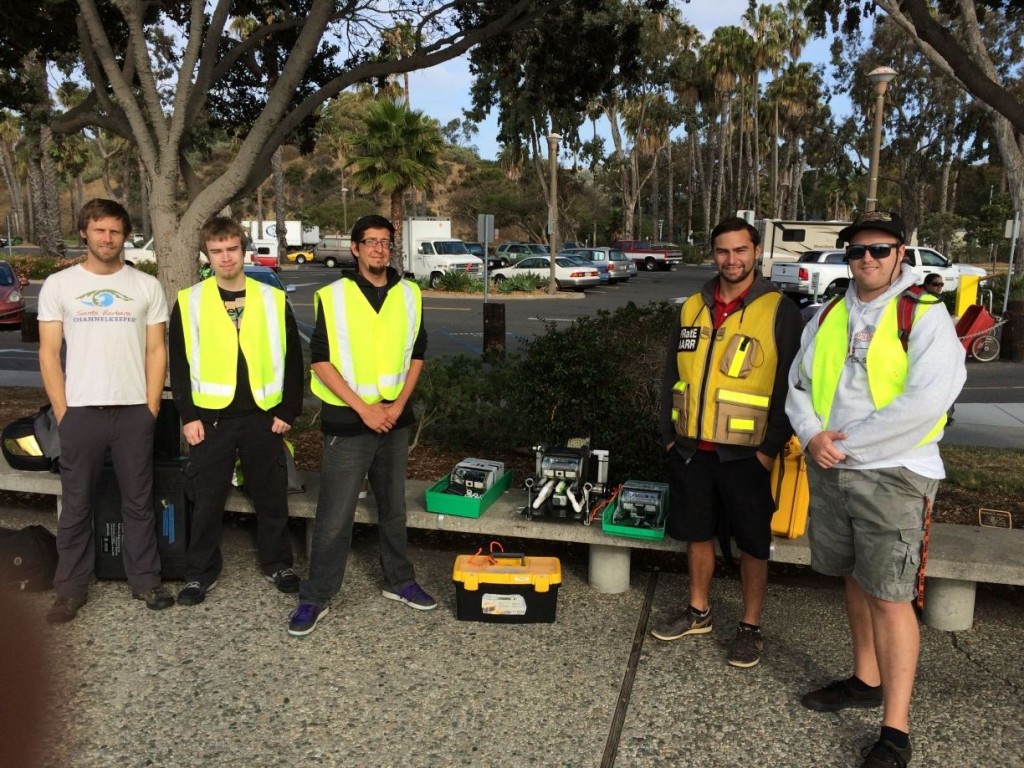
Ben Pitterle (Watershed and Marine Program Director, SB Channelkeeper) and our AARR oil spill team; Tim, Paul, Chris and Blake.
Our motley crew (well, technically we in the PIRatE Lab’s AARR group are motley…our colleagues actual professionals) set out Thursday morning from the Santa Barbara Harbor aboard the Santa Barbara Channelkeeper’s converted 31-foot JC lobster boat the R/V Channelkeeper.
A fantastic team
One of the best things about creating and using new tools such as our ROVs is the associated chance to meet tons of great new colleagues and partners. This initial hunt for benthic oil brought together three groups onboard the R/V Channelkeeper; our AARR team, Ben Pitterle from Santa Barbara Channelkeeper, and David Lang from OpenROV. Ben helms all things watershed and marine-related for Channelkeeper as their Watershed and Marine Program Director. David Lang is a co-founder of OpenROV and a partner on our current NOAA grant to educate K-12 students about our coastal environment via innovative curricula and tools (like ROVs). See our recent OpenROV Explorer’s Google Hangout for more info (we talk about looking for oil starting around the 15 minute mark).
Any Oil?
So the buried lead here is that we detected no oil, although this initial survey was quite preliminary. This is of course great news for Naples Reef and our nearshore environment! It is also no surprise as any deposited oil would be most likely be concentrated and therefore observable in the immediate shallow subtidal near the pipeline break up at Refugio. It is also important to note that with every passing day any deposited oil will likely become covered with sediment, detritus, etc. and be that much harder to detect with simple visual inspections.
A great test
This demo showed that our cheap ($1,000 baseline, $2,000 with our modifications) ROV can easily be used for subsurface surveys in the wake of oil spills. Even on a day with poor visibility thanks to the previous nights drizzle. Our small, OpenROV units are portable (fitting within a single Pelican Case or large backpack), adaptable (everything is open source and open to anyone to modify or adapt), and require minimal training (we can bring users up to speed in a handful of days). These units are also easy to assemble (we are doing builds now for various non-robotics savvy labs). Even we (our lab is pretty interdisciplinary but still dominated by ecologists, conservation biologists, and environmental scientists) can build these things…so you know they are user-friendly.
Lastly, it is key to reemphasize that these units could be considered expendable. We are not a wealthy lab by any stretch of the imagination, but sending tech into the sea is always a challenge. Sending tech into a natural disaster context on top of that already hostile milieu translates into a good chance you will lose or break something. We believe it is much better to put a $2,000 unit that can be operated by undergraduates on the case and in harm’s way rather than a several hundred thousand dollar unit requiring highly specialized operators, support staff, etc. This new tech we are proposing is both cheaper and much less riskier. It is even opening the door to potential citizen science groups monitoring swaths of our coasts, oil spill or no. How cool would that be?
This was a great proof of concept trial! We now know that we can indeed use our versatile OpenROV platform to go hunt for oil. We will be returning to sea next week to continue the hunt…hopefully with permission to enter the restricted zone. Keep you fingers crossed!
Exxon: Drive rather than Pipe
/in 1969 Santa Barbara Spill, News /by Sean Anderson One of the many policy consequences of the 1969 Santa Barbara Oil was a strong regulator of oil drilling and transportation at the county level in Santa Barbara County. Santa Barbara County’s Planning and Development Department’s powerful Energy Division is an amazingly strong office with a suite of powerful permitting and oversight tools across oil and gas production in the county. This office directly emerged from the fallout of the 1969 spill. Moreover, the heightened concern that the 1969 spill brought to us all merged with numerous other concerns in the 1970s:
One of the many policy consequences of the 1969 Santa Barbara Oil was a strong regulator of oil drilling and transportation at the county level in Santa Barbara County. Santa Barbara County’s Planning and Development Department’s powerful Energy Division is an amazingly strong office with a suite of powerful permitting and oversight tools across oil and gas production in the county. This office directly emerged from the fallout of the 1969 spill. Moreover, the heightened concern that the 1969 spill brought to us all merged with numerous other concerns in the 1970s:
- growing awareness of the importance of the Santa Barbara Channel as an amazingly diverse migratory corridor for virtually all of the large whales that live in the eastern Pacific
- very high numbers/rate of tanker traffic in and around the Santa Barbara Channel
- the acknowledgement that pipelines (despite their known risks and the fact no transportation mode is perfect) are the safest method to move gases and liquids in the U.S.
These swirling forces resulted in terrestrial pipelines being the mode of choice for the crude produced in the Santa Barbara Channel and various pipelines being created or adding on additional spurs throughout the 1980s, creating the pipeline network that we have now. This brings crude from coastal collection/distribution facilities to refineries in Santa Barbara and Kern Counties. See the map and detail below:

Oil and gas facilities across Santa Barbara (and extreme western Ventura and southern San Luis Obispo Counties). Source: Santa Barbara County Planning Division.
So our moving of crude via pipelines has reduced the risk of a maritime spill, but made us dependent on (effectively) a “single lane” highway for crude: the All American Coastal Pipeline. Obviously that is now down thanks to the May 19th break of trunk 901. In the week following the spill, an essentially identical trunk line (903) that brings crude to Kern County was deactivated over concerns that a similar break was possible given identical maintenance records, similar pipeline thinning, etc. This seems prudent given all the concerns about insufficient maintenance/oversight and all the hallmarks of what will be a huge political theater of a legal investigation. This has driven local production wells to be greatly staunched. Wellheads feeding into the Plains pipeline have been slowed to about a quarter of their normal flow rates. Currently that oil is being stored in the onshore facility (Las Flores Canyon, just to the right of the Refugio pipeline break in the above figures) very close to the break at Refugio. But even at this reduced production level, we will run out of onsite storage within 10-14 days.
This all brings us to yesterday when Exxon petitioned that ol’ Energy division at County Planning for permission to start trucking oil. And we are talking a lot of trucks. As in 192 more truck trips per day on the Gaviota stretch of the 101. As the LA Times is reporting this morning:
The company told Santa Barbara County officials Thursday that it wants to send a fleet of 5,000-gallon tanker trucks along U.S. 101 at a frequency of eight trucks per hour, 24 hours a day, every day, said Kevin Drude, the head of the county’s energy division.
“They are totally pinched off right now,” Drude said. “The only way out of the county is through that pipeline network.”
This will proceed until the pipeline can both be fixed AND certified for routine operation. The current estimate is months. Good luck with that, by the way.
Not to digress into other PIRatE Lab research, but we can add to the list of impacts from this spill all the increased road kill that will spin-up out of this increased trucking efforts. Large trucks such as these crude tankers are the least nimble vehicles out there and are much more likely to kill large wildlife. So while this may be inevitable given the options on the table, increased road-associated mortality is going to happen. This should be an additional factor in the mix added to the actual impact of this spill. My lab can actually estimate the amount of increased animal kill rates from this increased traffic…although we are still on the beach at the moment covered in tar balls. Stay tuned.
OpenROV Live Posting
/in boat, field data, Naples Reef, PIRatE Lab, Refugio, RPS, Santa Barbara, water quality /by Sean AndersonOrmond Beach Tar
/in Data, Field Work /by Sean Anderson
We sampled our two beach sites at Ormond Beach yesterday. As with our beaches in west Ventura County, we found a generally light to moderate tarring along the strand line. It was consistently patchy with the majority of the beach being only lightly tarred. We did also detect an oily sheen within the sand matrix towards our Arnold Road sites, indicating the beach was hit with a slick in addition to more weathered tar in the last several days.
We found a dead round skate and a California sea lion within the wash zone when we arrived in the early morning. As you would expect in June, we had relatively few shorebirds, but noted several California least tern breeding pairs and many snowy plovers. Most plovers were back in amongst our dune complex, but a few were outside in the main beach area. While I saw the plovers frequently running in and out of the tar/wrackline, I did not see any direct feeding within the tar or direct interactions with the tar itself.
Tar clean-up teams had not yet arrived to clean-up Ormond at the time of our surveys. They were slated to arrive the next day, June 4.
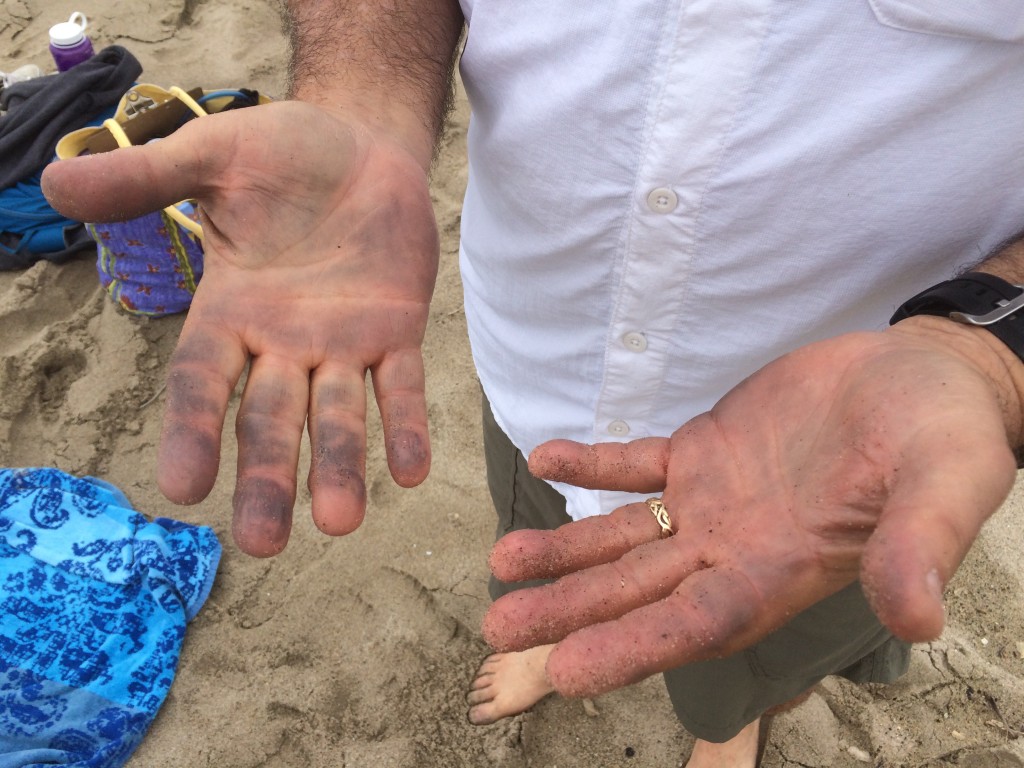
Dr. Don Rodriguez’s hands covered in a light oil sheen following our regular sand coring, indicating an oil sheen hit the beach sometime in the preceding several days. June 3, 2015.

A dead California sea lion at Ormond Beach. This individual was newly located this morning as the tide receded. This photograph was taken several hours later after turkey vultures had begin to attack the carcass. No external oil was evident. There was a similar lack of oil in the nasal and oral cavities. June 3, 2015.
It keeps coming…
/in News /by Sean AndersonNow we are seeing additional tar balls in Long Beach (in southern Los Angeles County).
This tarring pattern has become all too familiar. We think we are done with the oil “rain,” then we get a highly patchy deposition event which tars beaches with moderate to light tar balls (and occasionally an oil sheen). The event produces a highly variable deposition over several miles of coastline. In turn, this leads some of the public who happened upon a relatively high concentration of tar balls to say “oh my God, there is so much tar here compared to what we normally see here…this is horrible” and others who happen upon a low or non-existent level of tar say “oh my God, this is nothing and totally overblown…this is such a manufactured crisis.” The Joint Incident Command will issue a press release saying it will take a long-time to chemically fingerprint the oil (see my previous post), but they will treat it as related to the Refugio oil spill until they get evidence otherwise. They will then send in a bunch of contractors to walk the beach/pick-up the tar.
We saw this happen in southern Santa Barbara County. Then northern Los Angeles County (the mid Santa Monica Bay/South Bay Cities). Then Ventura County. Then along the Malibu Coast…and now southern Los Angeles County. If this petroleum is not pipeline oil, it is an amazing coincidence.
As of four hours ago, the LA Times is reporting:
Four miles of Long Beach coast closed after tar balls wash ashore
A four-mile stretch of the coast in Long Beach was closed Wednesday evening after tar balls washed ashore, threatening the safety of beachgoers, authorities said.
The small pieces of tar began spotting the sand earlier in the day between 1st Place and 72nd Place, said city fire department spokesman Jake Heflin.
Cleanup crews are working to remove the tar, he said.
The U.S. Coast Guard has collected samples of the tar balls for testing, which will help pinpoint the source of the petroleum product. Officials said there was no sign that the tar balls came from operations by the Long Beach Gas and Oil Department.
Laboratory testing will help investigators determine whether the tar traveled from Santa Barbara County, where a May 19 oil spill released as much as 101,000 gallons of crude. An estimated 21,000 gallons of oil spewed into the Pacific.
In recent days, tar balls have washed ashore in Ventura County, Malibu and the South Bay, where a nearly eight-mile section of the beach was closed for three days last week.
Long Beach city officials have advised people to stay away from beaches, cautioning that the tar may irritate skin or cause longterm health effects.
Da Grunion be here!
/in beach, Data, fish, fisheries /by Sean AndersonJune 2nd and 3rd are the peak spawning days of the year for our California grunion in 2015. These fish are laying eggs and sperm as I type this into some of our newly tarred high tide lines across SoCal.
Pathos And The Mounting Pressure To Do Something
/in News, Policy /by Sean AndersonThe media and public are apparently getting more and more worried about marine mammals and birds fouled or killed by oil spilled from the May 19 pipeline break. At least part of this current worry can be traced to pictures that began showing up on Facebook late last week of heavily oiled dolphins (or at least one or two) near Ventura State Beach and the constant drip, drip of implied or direct accusations of ineptness, delay, or other failings of the response. Now the Santa Barbara Independent is reporting that the recorded mammal deaths rose sharply by Monday June 1:
On Monday alone, responders organized by the California Department of Fish & Wildlife and the Oiled Wildlife Care Network recovered the bodies of 30 dead sea birds (mostly brown pelicans) and 13 marine mammals (mostly sea lions). Five oiled birds and two mammals were found alive.
Since May 19, nine dead dolphins — some with mouths full of tar — have washed onto South Coast beaches. A total of 45 mammals and 80 birds have been found dead in the last two weeks. Of the 57 live birds and 38 mammals rescued, eight birds and seven mammals died in care. Body counts for fish, crustaceans, and other types of intertidal animals were not immediately available.
| Total Birds | 137 |
|---|---|
| Birds recovered: live | 57 |
| Birds recovered: dead | 80 |
| Total Mammals | 82 |
| Mammals affected: live | 38 |
| Mammals dead | 45 |
Conspicuous vertebrates impacted by the Refugio Oil Spill. Data from May 19-June 1, 2015. Source: Joint Incident Command.

Dolphin kill that washed up in Ventura in the wake of the May 19, 2015 Refugio Oil Spill. Image source: Naples News.
To be sure this spill has impacted and undoubtedly will be impacting many more conspicuous marine vertebrates in the days to come. We should be counting these impacts, working to minimize further impacts, and (post clean-up) restoring these systems. With every picture and data point, the pressure to do something can seem tremendous. We all feel this. But rushing to judgement as to what happened, while understandable, rarely produces the best possible policy response.

A pelican covered in oil sits on a beach about a mile west of Refugio State Beach, Calif., Wednesday, May 20, 2015. Image: Kenneth Song/The News-Press via AP.
Clearly those in the media spotlight (e.g. Plains All American, the Joint Incident Command) seek to tamp down speculation and minimize the hit to their public image. On the other side, advocates for reduced dependence on oil or who dislike their homes and businesses being spoiled by hydrocarbons see this as their opportunity to strike while the iron is hot. The environmental community is particularly charged up by this event and see this immediate post-spill period as a key time to make progress against increased drilling and a carbon-intensive economy. It is important to understand that this spill comes in the wake of the defeat of the anti-oil constituency’s anti-fracking ballot Measure P by what was widely viewed as “outside money” from the oil industry in last November’s Santa Barbara County elections. This spill only added insult to injury in the minds of many environmental activists in Santa Barbara County and has sparked a renewed interest in getting something done.
While the inevitable political jockeying and positioning has begun, of particular note is movement by political leaders to respond to this spill. As noted by Henry Dubroff in last week’s Pacific Coast Business Times:
Political fortunes will rise or fall based on what happens. California Attorney General Kamela Harris is running to replace Barbara Boxer in the U.S. Senate and her investigation into the Refugio disaster could boost her cred with green voters. Lt. Gov. Gavin Newsom, a most ambitious politician, casts one of the three votes on the state lands commission. In the race to replace retiring U.S. Rep. Lois Capps, a Santa Barbara Democrat and staunch environmentalist, the impact of the Refugio spill will loom very large.
To this we can add a rush by our local representatives to do something in the legislative arena as quickly as possible. The Ventura County Star reports as on late Tuesday afternoon:
“If we do nothing, and then something happens again, then shame on us,” said Sen. Hannah-Beth Jackson, D-Santa Barbara.
Jackson said she will submit legislation designed to beef up the state’s pipeline inspections and also to empower local fishermen to quickly respond to marine oil spills.
Assemblyman Das Williams, D-Carpinteria, will propose a bill to require all oil pipelines in offshore or near-shore areas be equipped with automatic shut-off valves, which the Plains All American Pipeline’s facility did not have.
“From what I know of the gap in time from when they knew something about the spill and when the cleanup began, I think it’s safe to say an automatic shut-off valve would have reduced the scale of the spill,” he said.
Because it is well past the deadline for introducing new bills in the Legislature this year, Jackson and Williams intend to strip the language from existing bills and amend them to include their oil spill-related proposals.
Jackson noted that it took six hours for boats from Los Angeles dispatched by the state Office of Oil Spill Prevention and Response to arrive in Santa Barbara. Had the crews of local fishing boats been trained and equipped, she said, they could have responded much more quickly to begin the cleanup.
The proposal is modeled after a program already in place in Alaska.
“Nobody knows the oceans, the currents or the winds better than fishermen. They’re anxious to help,” she said. “The earlier you can respond to a problem, the less likely it is to spread.”
Although the details have not been developed, Jackson said she envisions having state hazardous materials experts train willing fishermen to become volunteer responders.
I’m all for change and doing things better. God knows we can improve on many, many fronts. But I would hope we do this armed with facts and not an overly worried sense of urgency stemming from appeals to pathos. There is much more to the story than those charismatic critters. Amongst other things, I would hope for an improved monitoring network of ecological and social systems, cheaper and more portable/rapidly deployable response systems such as the ROV technology we are developing in my lab, etc. Only time will tell how this all turns out. But one things is for sure; the more oiled dolphins we see, the less of a reasoned approach we all will take.

